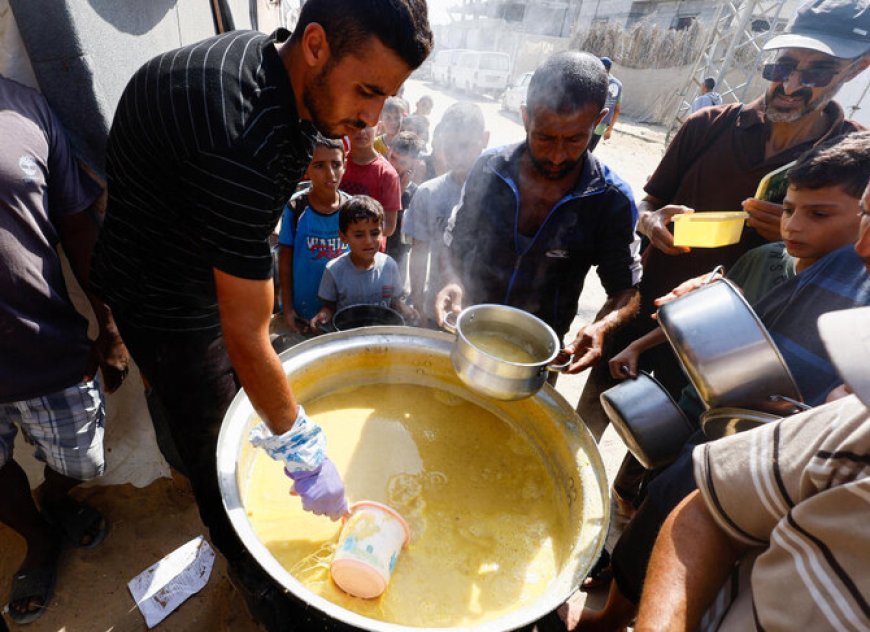This winter, 345,000 people in Gaza will go hungry, which the UN calls "catastrophic."
A UN-backed report released Thursday said that about 345,000 people in Gaza are facing "catastrophic" levels of hunger this winter because food supplies have stopped.

A UN-backed report released Thursday said that about 345,000 people in Gaza are facing "catastrophic" levels of hunger this winter because food supplies have stopped. The report also warned that there is a constant risk of famine in the Palestinian territory. This is more than the 133,000 people who are currently considered to be suffering "catastrophic food insecurity," according to a list made by UN agencies and NGOs.
The Integrated Food Security Phase Classification (IPC) report said that more humanitarian aid came into Gaza this summer, which helped some people. But in September, the least amount of commercial and emergency goods came into Gaza since March. That's why it thought that between November 2024 and April 2025, 345,000 people, or 16% of the population, would be suffering catastrophic food instability (IPC Phase 5). The study said that the recent "sharp decline" in aid "will profoundly limit the ability of families to feed themselves and access essential goods and services in the coming months, unless reversed."
The US told Israel on Tuesday that it could cut off some of its billions of dollars in military aid if it didn't improve how it sends aid to the Gaza Strip within 30 days. Philippe Lazzarini, the head of the UN agency for Palestinian refugees, also warned on Wednesday that there was a chance of famine in the area, where Israel's response to Hamas's attack on October 7 of last year destroyed large parts of the land. "There is a risk of famine from November 2024 to April 2025 as long as there is conflict and limited access for humanitarian aid," the IPC report said. "The very high number of people living in an area that is getting smaller and smaller, in makeshift shelters that only sometimes have access to humanitarian supplies and services, raises the risk of epidemics and a disaster of a scale that has never been seen before." The report also said that new evacuation orders and stronger Israeli attacks were "already increasing the likelihood of this worst-case scenario occurring."
Acute hunger will affect about 60,000 children between the ages of six months and four years between November and April. Beth Bechdol, deputy director-general of the UN's Food and Agriculture Organization, said, "We must act now to stop severe hunger and malnutrition." She said, "Cease all hostilities right away and allow humanitarian access to bring them critical and essential food aid and agricultural inputs in time for the winter crop planting season so they can grow food." Danny Danon, Israel's representative to the UN, said on Wednesday that the problem wasn't a lack of help but that Hamas was stealing and taking over deliveries.The International Labour Organization said on Thursday that since the Israel-Hamas war began, unemployment in Gaza has risen to almost 80% and the economy of the destroyed region is almost completely broken.
The UN agency said that since the war with Israel started a year ago, economic output has dropped by 85%, putting almost the whole 2.3 million people into poverty. The ILO said that the war in Gaza and the West Bank has had "unprecedented and wide-ranging devastation on the labor market and the wider economy across the Occupied Palestinian Territory." ILO stands for the International Labour Organization. The ILO said that between October 2023 and the end of September 2024, the jobless rate in the West Bank averaged 34.9%. The economy shrinked by 21.7% over the previous 12 months. The Geneva-based group says that before the crisis, the jobless rate in Gaza was 45.3% and in the West Bank it was 14%. The ILO said that people in Gaza either lost all of their jobs or found part-time or irregular work that was "mainly centered on the provision of essential goods and services."
According to Israeli counts, shooters led by Hamas struck on October 7 and killed about 1,200 people and took about 250 hostage. This is when Israel went on the offensive. According to the health officials in Gaza, Israel's reaction has killed more than 42,000 people. UN satellite data shows that over 163,000 houses, or two-thirds of Gaza's pre-war structures, have been damaged or destroyed. Israel says its operations are meant to find and kill Hamas terrorists who are hiding in tunnels and among the civilians in Gaza. The crisis has spread to the West Bank, where Israeli restrictions on the movement of people and goods, along with wider trade limits and problems in the supply chain, have had a big effect on the economy, according to the ILO.
Israel says it had to do what it did in the West Bank to protect Israeli people and fight terrorist groups backed by Iran. "The war in the Gaza Strip has had effects that go far beyond deaths, terrible conditions for people in need, and damage to property," said Ruba Jaradat, ILO regional head for Arab states.













































